The Dravida style of temple architecture is a distinctive and prominent architectural form that originated in the southern part of India. Characterized by its towering structures, intricate carvings, and elaborate rituals, the Dravida style has left an indelible mark on the landscape of Indian temples.
Historical Background and Origin
The roots of the Dravida style can be traced back to the early centuries of the Common Era, with its emergence in the southern regions of India. The Pallava and Chola dynasties played a crucial role in shaping and refining this architectural tradition. Over time, the Dravida style evolved, incorporating various influences and achieving its peak during the Chola period.

Importance in Indian Temple Architecture
The Dravida style holds immense importance in the panorama of Indian temple architecture. Its unique features and spiritual significance have made it a symbol of cultural and religious identity.
Dravida temples not only serve as places of worship but also stand as testaments to the artistic and engineering prowess of ancient Indian civilizations. The enduring legacy of the Dravida style continues to inspire architects, historians, and devotees alike.
If you want to know about the Types of slabs or Permeable concrete or Islamic architecture, please click the link.
1) Key Features of Dravida Style
Vimana (Tower) – Significance and Characteristics
The Vimana, or tower, is a hallmark of Dravida architecture, towering over the sanctum sanctorum of the temple. It symbolizes the ascent to the divine and is adorned with intricate carvings, sculptures, and decorative elements.
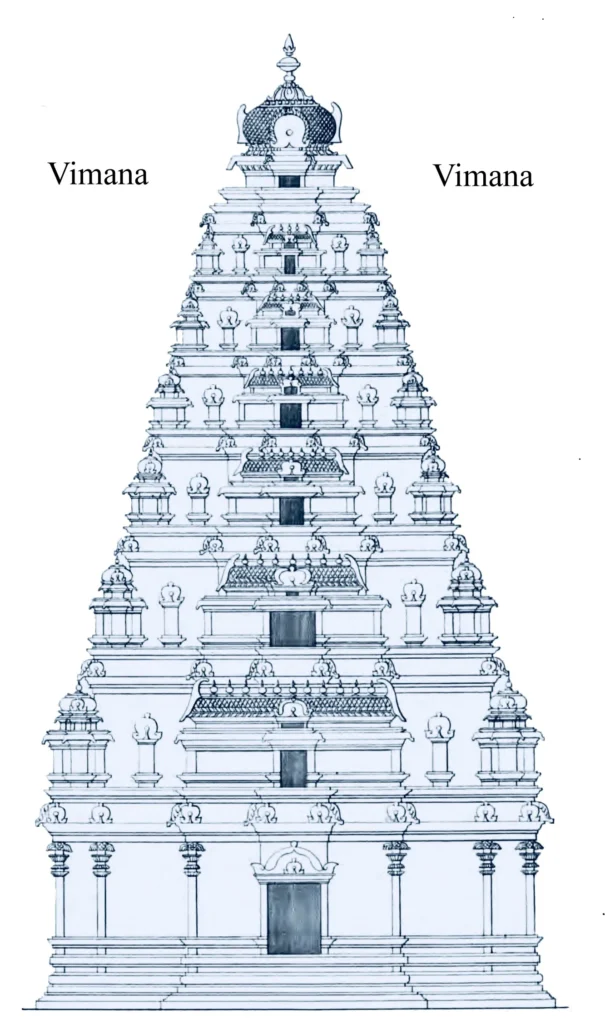
The Vimana often follows a pyramidal or stepped structure, representing the cosmic mountain Mount Meru. Its verticality is seen as a spiritual journey, reflecting the soul’s ascent towards enlightenment.
Each tier of the Vimana holds symbolic significance, contributing to the overall spiritual experience within the temple.
Mandapa (Hall) – Purpose and Design Elements
The Mandapa serves as a congregation hall for devotees, providing a space for religious rituals, ceremonies, and community gatherings. Its purpose extends beyond a mere architectural element, acting as a bridge between the secular and the divine.
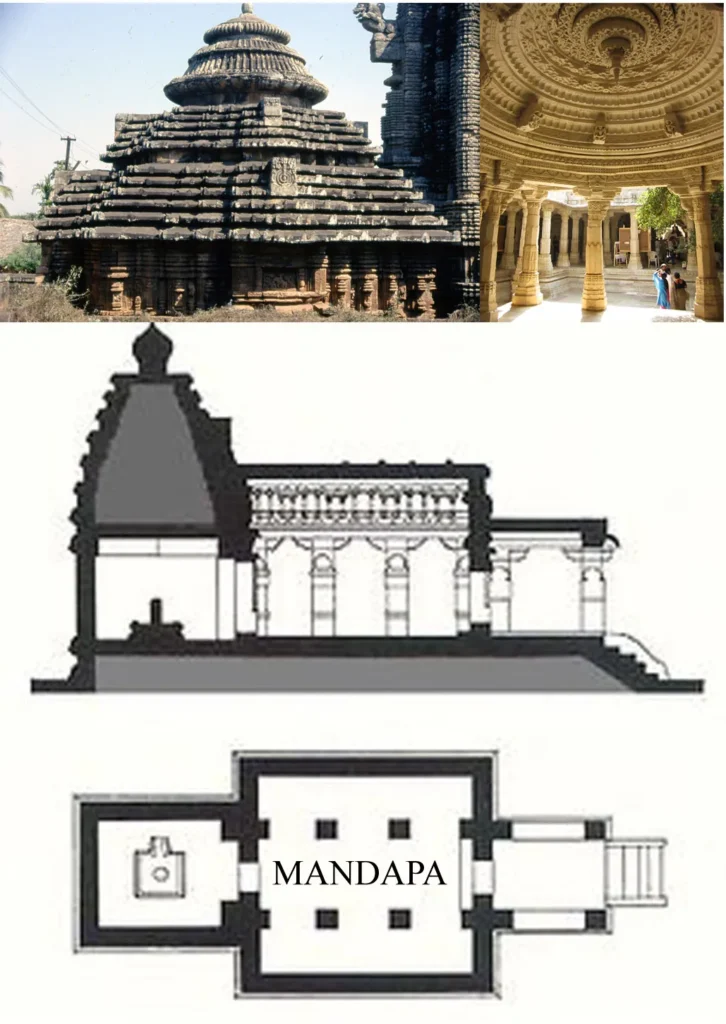
The Mandapa is characterized by intricately carved pillars, often depicting mythological stories and divine beings. The design elements of the Mandapa showcase the aesthetic sensibilities of Dravida architecture, with meticulous attention to detail and proportion.
Gopuram (Entrance Tower) – Function and Architectural Details
The Gopuram, or entrance tower, is a monumental and ornate structure that serves as the gateway to the temple complex. It is not merely a decorative element but holds functional significance by demarcating the sacred space from the external world.
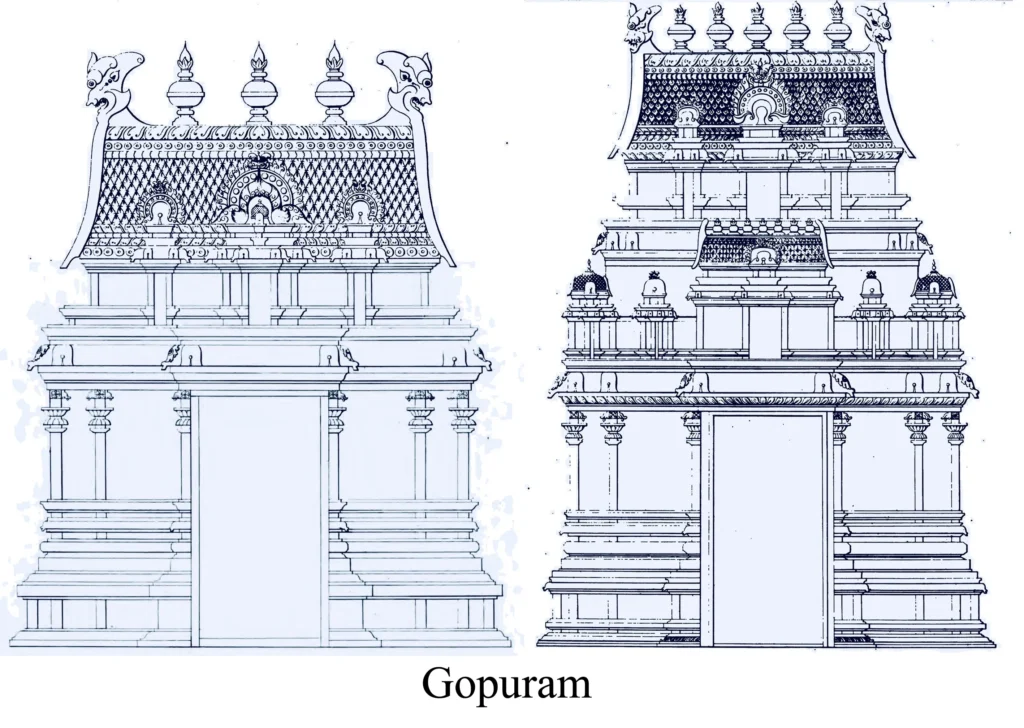
The Gopuram is adorned with sculptures, statues, and vibrant paintings depicting deities and mythological narratives. Its pyramidal shape and elaborate details showcase the grandeur and opulence associated with Dravida architecture. The towering Gopuram is often visible from a distance, acting as a beacon inviting devotees into the spiritual realm of the temple.
2) Iconography in Dravida Temples
Sculptures and Carvings – Religious Motifs and Deities
The sculptures and carvings in Dravida temples are a testament to the rich religious and cultural tapestry of India. Devotees encounter a profusion of intricate carvings depicting various religious motifs and deities.
Vishnu, Shiva, Parvati, and other major Hindu gods and goddesses find expression in these carvings, each laden with symbolic significance. These artistic creations not only serve a decorative purpose but also act as visual narratives that convey religious teachings and stories.
Symbolism in Temple Art
Symbolism plays a crucial role in Dravida temple art, with every sculpture and carving carrying profound meaning. The intricate details of motifs such as lotus flowers, serpents, and divine animals hold symbolic importance within Hindu cosmology.
Additionally, geometric patterns and architectural elements themselves convey deeper meanings, representing cosmic order and the interconnectedness of the spiritual and material worlds. Understanding the symbolism enriches the religious experience for devotees and visitors alike.
Integration of Mythology in Architecture
Dravida architecture seamlessly integrates mythology into its structural design. Temples are often designed to mirror the celestial abodes of gods, and the layout may reflect cosmic patterns described in Hindu mythology.
The choice of materials, placement of sculptures, and the overall layout of the temple complex are influenced by mythological narratives. The temples themselves become tangible embodiments of divine stories, creating a sacred space where devotees can connect with the mythology that underpins their religious beliefs.
3) Notable Dravida Style Temples
Brihadeeswarar Temple (Thanjavur)
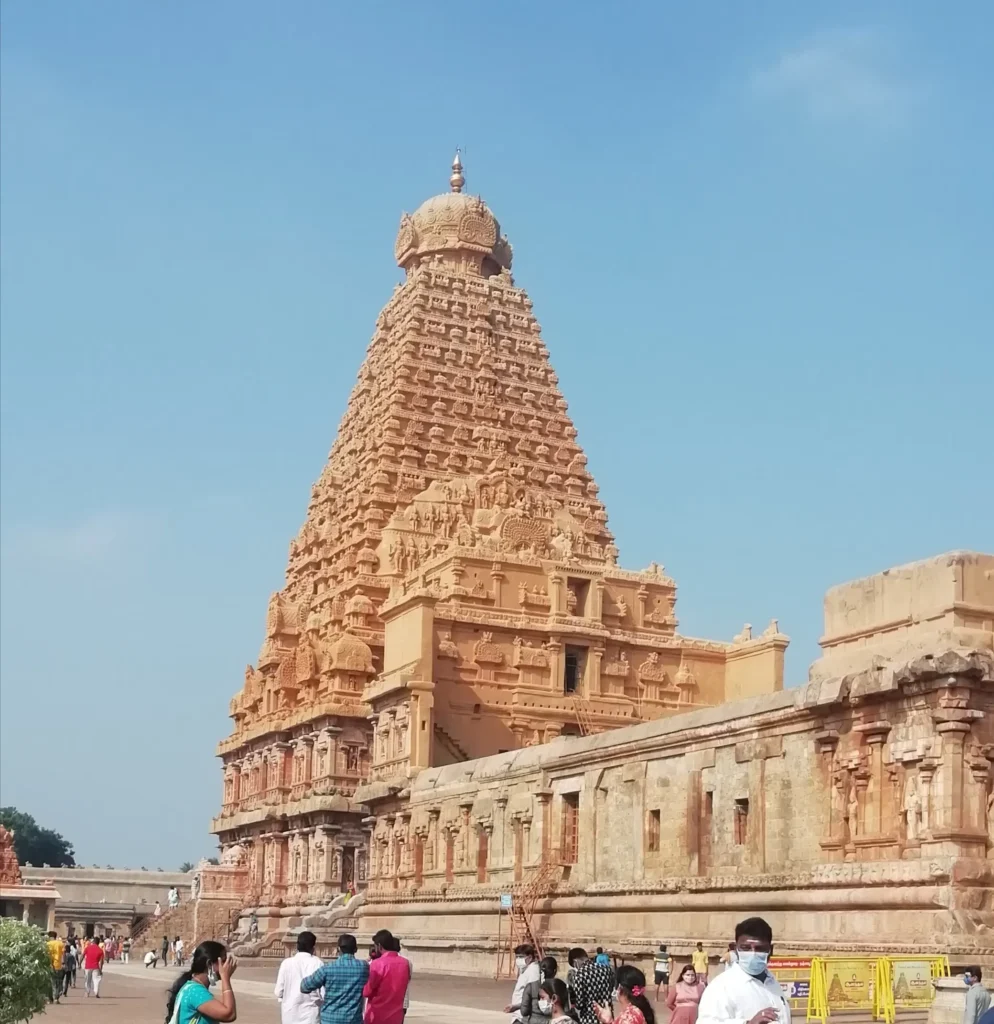
The Brihadeeswarar Temple, also known as the Peruvudaiyar Kovil, stands as a majestic example of Dravida architecture. Built by Rajaraja I in the 11th century, this UNESCO World Heritage Site is dedicated to Lord Shiva.
The temple’s Vimana, towering over 200 feet, is a marvel of engineering and artistic expression. The intricate carvings on the walls depict various episodes from Hindu mythology, and the Nandi statue at the entrance adds to the grandeur.
The Brihadeeswarar Temple exemplifies the scale and sophistication achievable in Dravida architecture during the Chola dynasty.
Meenakshi Temple (Madurai)
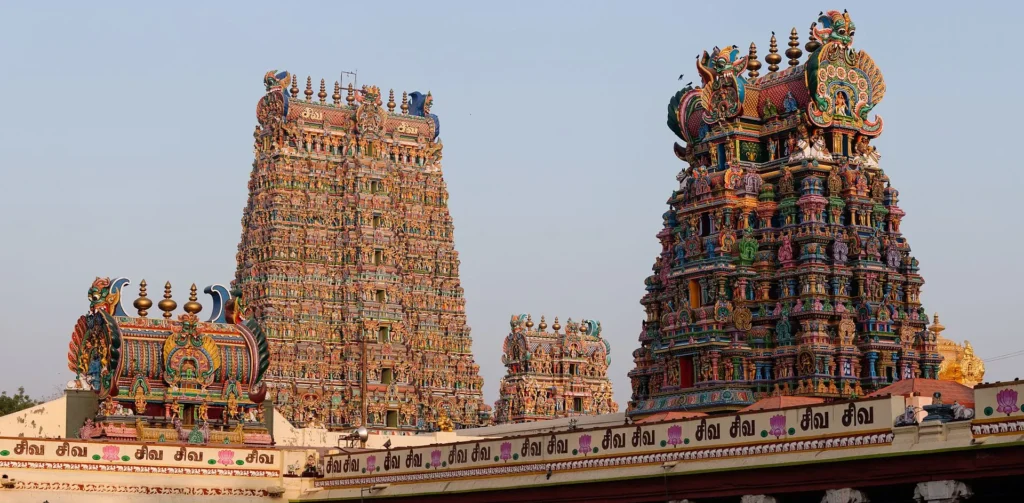
The Meenakshi Temple in Madurai is a vibrant hub of Dravida architecture and one of the oldest and most significant temples in South India.
Dedicated to Goddess Meenakshi (Parvati) and Lord Sundareswarar (Shiva), the temple complex boasts a mesmerizing array of Gopurams, each adorned with thousands of sculptures and carvings. The Mandapams within the temple display intricate pillared halls with elaborate carvings narrating tales from mythology.
The Meenakshi Temple is not just a religious center but a living testament to the artistic prowess and spiritual significance of Dravida architecture.
Ranganatha Swamy Temple (Sri Rangam)
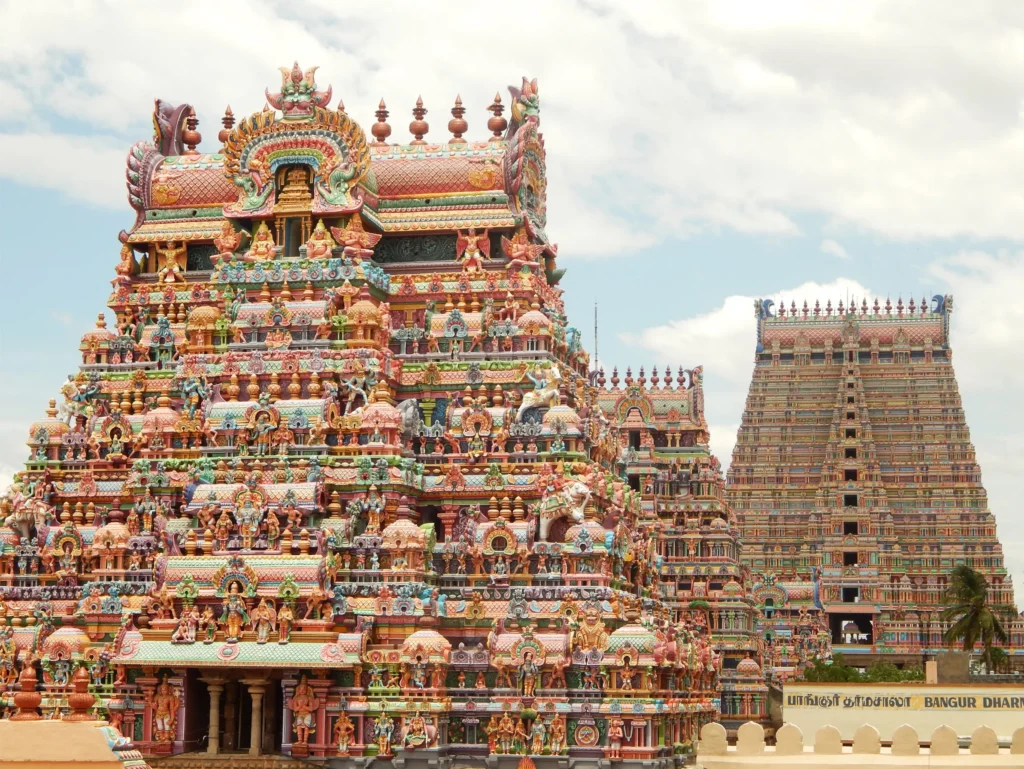
The Ranganatha Swamy Temple, situated on an island in the Cauvery River, is renowned for being one of the largest functioning temples globally.
Dedicated to Lord Ranganatha, a form of Vishnu, the temple’s complex is a sprawling example of Dravida architecture. The Rajagopuram, the monumental entrance tower, is a remarkable structure with intricate sculptures depicting various episodes from the epic Ramayana.
The temple’s architectural layout and sculptures reflect the rich religious and cultural heritage associated with Dravida temples, making it a significant pilgrimage site in South India.
4) Contribution of Pallavas to Dravidian Architecture
The Pallava dynasty, which ruled over parts of South India from the 3rd to the 9th centuries, made significant contributions to Dravidian architecture. Dravidian architecture is a style of temple architecture that is native to the South Indian region and is characterized by its distinctive features. The Pallavas played a crucial role in shaping and developing this architectural style.
Here are some of their notable contributions:
Introduction of Rock-cut Architecture: The Pallavas were pioneers in the creation of rock-cut architecture. Mamallapuram (also known as Mahabalipuram), a UNESCO World Heritage site, is a remarkable example of Pallava rock-cut architecture. The famous Rathas (chariot-shaped temples), cave temples like the Varaha Cave, and the monolithic Shore Temple are excellent illustrations of their expertise in carving out structures from solid rock.
Creation of Monolithic Temples: The Pallavas are known for their creation of monolithic (carved from a single piece of stone) structures. The Shore Temple at Mamallapuram is an iconic example. This temple is dedicated to Lord Shiva and is built with blocks of granite. The precision with which these temples were carved is a testament to the Pallavas’ architectural skills.
Development of Mandapa Architecture: Pallava architects contributed to the evolution of Mandapa architecture. Mandapas are hall-like structures often found in front of the main sanctum of a temple. The Kailasanatha Temple in Kanchipuram, built by the Pallavas, showcases intricate mandapa architecture with elaborately carved pillars and sculptures.
Innovations in Temple Layouts: The Pallavas played a role in shaping the basic layout of South Indian temples. They introduced certain architectural elements like the Vimana (tower over the sanctum sanctorum), Mandapa, and Gopuram (entrance tower). These elements later became integral to the Dravidian temple architecture style.
Artistic and Sculptural Achievements: Pallava art and sculpture reached great heights during their rule. The intricate carvings on the temple walls, depicting various mythological stories, deities, and cultural motifs, reflect their artistic accomplishments. The panels at Mamallapuram, for instance, depict scenes from the Mahabharata and Ramayana.
Influence on Later Dynasties: The architectural styles and innovations introduced by the Pallavas had a lasting impact on the Dravidian architectural tradition. Subsequent dynasties, including the Cholas and the Vijayanagara Empire, were influenced by Pallava architecture, incorporating and further developing their ideas.
In summary, the Pallavas made significant contributions to Dravidian architecture through their innovations in rock-cut architecture, monolithic temples, mandapa designs, temple layouts, and artistic achievements. Their influence endured, shaping the architectural landscape of South India for centuries to come.
5) Contribution of Cholas to Dravidian Architecture
The Chola dynasty, which thrived in South India from the 9th to the 13th centuries, made substantial contributions to Dravidian architecture. The Cholas were prolific builders, and their architectural achievements are marked by grand temples and intricate sculptures.
Here are some key contributions of the Cholas to Dravidian architecture:
Grand Temple Complexes: The Cholas constructed large and elaborate temple complexes that served as centers of worship, administration, and cultural activities. The Brihadeshwara Temple in Thanjavur, built by King Rajaraja Chola I in the 11th century, is a magnificent example. It is one of the largest temples in India and showcases the grandeur and scale of Chola architecture.
Vimana and Shikhara Design: Chola architects made advancements in the design of Vimanas (the tower above the sanctum sanctorum) and Shikharas (towering structures over the main shrine). The Vimana of the Brihadeshwara Temple is particularly noteworthy for its height and architectural brilliance. The design elements introduced by the Cholas influenced later temple architecture in South India.
Dravida and Nagara Styles Fusion: The Cholas were adept at blending the Dravida and Nagara styles of temple architecture. The Dravida style is native to South India and is characterized by pyramidal towers, while the Nagara style is prevalent in North India and features a curvilinear shikhara. The fusion of these styles is evident in Chola temples, creating a unique architectural synthesis.
Bronze Casting and Sculptures: Chola craftsmen excelled in bronze casting, creating exquisite metal sculptures of deities. The Chola period is considered a golden age for bronze sculpture in South India. The Nataraja (the dancing Shiva) bronze sculptures from this period are celebrated for their artistic excellence and religious significance.
Intricate Carvings and Inscriptions: Chola temples are adorned with intricate carvings and inscriptions. The walls of these temples depict various episodes from Hindu mythology, showcasing the artistic and storytelling prowess of Chola sculptors. The inscriptions provide valuable historical and cultural information, including details about the temple construction, grants, and donations.
Expansion and Patronage of the Arts: The Chola rulers, particularly Rajaraja Chola I and Rajendra Chola I, played a crucial role in patronizing the arts and temple construction. They provided financial support to artisans, poets, and scholars, contributing to the flourishing of literature, music, dance, and other cultural expressions.
Development of Temple Towns: Chola rulers often developed entire towns around major temples, creating vibrant cultural and economic centers. These temple towns, such as Thanjavur and Gangaikonda Cholapuram, became important pilgrimage sites and contributed to the social and economic development of the region.
The Cholas significantly influenced Dravidian architecture, leaving a lasting legacy that continues to be admired and studied today. Their temples stand as marvels of engineering, art, and spirituality, showcasing the rich cultural heritage of South India during the Chola period.
Indian architecture is indeed amazing and complex!